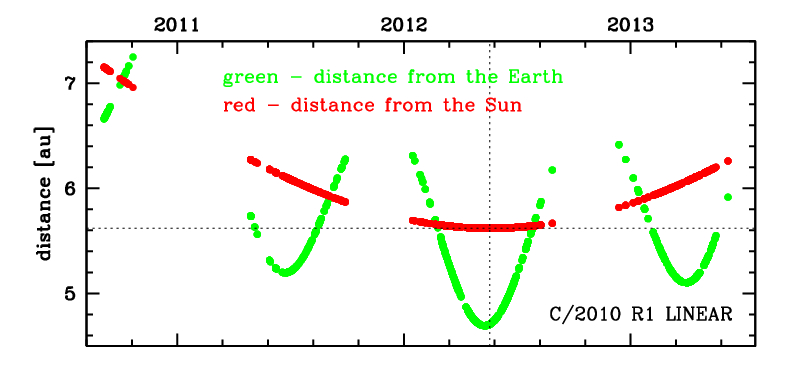| Solar System Dynamics & Planetology Group |
 |
C/2010 R1 LINEAR |  |
| Solar System Dynamics & Planetology Group |
 |
C/2010 R1 LINEAR |  |

| number of observations | 1574 |
| number of residuals | 3106 |
| data interval | 2010 Sep. 4 — 2013 June 5 |
| rms [arcsec] | 0.43 |
| orbit quality class | 1a+ |
| Epoch (TT) | 20120602.0 | = JD 2456080.5 |
| time of perihelion passage (TT) | 20120518.897264 | ± 0.000329 |
| perihelion distance | 5.62142117 | ± 0.00000251 |
| eccentricity | 1.00366427 | ± 0.00000290 |
| argument of perihelion [deg] | 114.496326 | ± 0.000037 |
| longitude of the ascending node [deg] | 343.649456 | ± 0.000017 |
| inclination [deg] | 156.933395 | ± 0.000004 |
| inverse semimajor axis [10-6 au-1] | -651.84 | ± 0.52 |
| Epoch (TT) | 17050831 | |
| time of perihelion passage (TT) | 20120518.570947 | ± 0.000333 |
| perihelion distance | 5.62134619 | ± 0.00000249 |
| eccentricity | 0.99975559 | ± 0.00000290 |
| argument of perihelion [deg] | 114.531799 | ± 0.000037 |
| longitude of the ascending node [deg] | 343.648214 | ± 0.000017 |
| inclination [deg] | 156.925538 | ± 0.000004 |
| inverse semimajor axis [10-6 au-1] | 43.48 | ± 0.52 |
| Epoch (TT) | 23190704 | |
| time of perihelion passage (TT) | 20120518.214822 | ± 0.000333 |
| perihelion distance | 5.62509170 | ± 0.00000250 |
| eccentricity | 0.99957374 | ± 0.00000290 |
| argument of perihelion [deg] | 114.528021 | ± 0.000037 |
| longitude of the ascending node [deg] | 343.702395 | ± 0.000017 |
| inclination [deg] | 156.950481 | ± 0.000004 |
| inverse semimajor axis [10-6 au-1] | 75.78 | ± 0.52 |